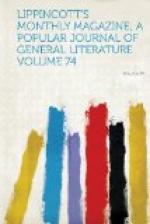Thomas and Falling were despatched at once with the tidings into Virginia, the two Williamses were sent to warn the garrison at Fort Patrick Henry, and then the little force at Watauga furbished up their rifles and waited in grim expectation the coming of Oconostota.
But the garrison at Fort Patrick Henry was the first to have tidings from the Cherokees. Only a few men were at the fort, the rest being scattered among the outlying stations, but all were within supporting-distance. On the 19th of July the scouts came in and reported that a large body of Indians was only about twenty miles away and marching directly upon the garrison. Runners were at once despatched to bring in the scattered forces, and by nightfall the one hundred and seventy were gathered at the fort, ready to meet the enemy. Then a council of war was held by the six militia captains to determine upon the best plan of action. Some were in favor of awaiting the attack of the savages behind the walls of the fort, but one of them, William Cocke, who afterward became honorably conspicuous in the history of Tennessee, proposed the bolder course of encountering the enemy in the open field. If they did not, he contended that the Indians, passing them on the flank, would fall on and butcher the defenceless women of the settlements in their rear.
It was a step of extreme boldness, for they supposed they would encounter the whole body of seven hundred Cherokees; but it was unanimously agreed to, and early on the following morning the little army, with flankers and an advance guard of twelve men, marched out to meet the enemy. They had not gone far when the advance guard came upon a force of about twenty Indians. The latter fled, and the whites pursued for several miles, the main body following close upon the heels of the advance, but without coming upon any considerable force of the enemy. Then, being in a country favorable to an ambuscade, and the evening coming on, they held a council and decided to return to the fort.




